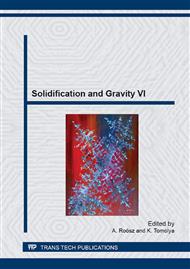p.91
p.97
p.103
p.109
p.115
p.121
p.127
p.133
p.140
Simulation of Dendritic Growth in Multicomponent Aluminium Alloys by Point Automata Method
Abstract:
A numerical model is developed to describe the dendritic growth of multicomponent aluminium alloys, based on a coupled deterministic continuum mechanics heat and species transfer model and a stochastic localized growth model that takes into account the undercooling temperature, curvature, kinetic, and thermodynamic anisotropy. The stochastic model receives temperature and concentration information from the deterministic model and the deterministic heat and species diffusion equations receive the solid fraction information from the stochastic model. The heat and species transfer models are solved on a regular grid by the standard explicit Finite Difference Method (FDM). The dendritic growth model of multicomponent alloy [1,2] is solved by a novel Point Automata (PA) approach [3,4] where the regular cells of the Cellular Automata (CA) method are replaced by the randomly distributed points and neighborhood configuration, similar as appears in meshless methods. The PA method was developed in order to circumvent the mesh anisotropy problem, associated with the classical CA method. The present paper extends our previous developments of Pa method to multicomponent alloys. A comparison of the results, obtained by the PA and CA method is shown for Al-5.3% Zn-2.35% Mg-1.35% Cu-0.5% alloy.
Info:
Periodical:
Pages:
115-120
Citation:
Online since:
May 2014
Authors:
Price:
Сopyright:
© 2014 Trans Tech Publications Ltd. All Rights Reserved
Share:
Citation:


